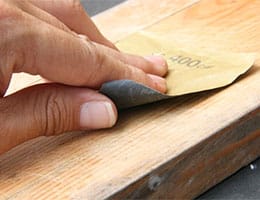 A sandpaper is a marine fish that is part of the suborder of squalids . It is a species that can measure up to a meter in length, with a small head and toothed mouth.
A sandpaper is a marine fish that is part of the suborder of squalids . It is a species that can measure up to a meter in length, with a small head and toothed mouth.
The sandpapers have a grayish body that turns whitish in the abdominal area and exhibits reddish spots on the back. Although the skin is not covered with scales , it has very hard horny protuberances that make it very rough. That is why humans use the dry skin of this animal to clean and polish wood and metals .
The idea of sandpaper, therefore, may refer to the skin of this fish which, after a drying process, is used to clean and polish surfaces. Sandpaper is also called sandpaper that, with emery , sand or ground glass adhered to one of its sides, is used for the same purpose.
Sandpaper , in short, imitates the skin of the fish. It is produced through the adhesion of an abrasive material to the blade, so that it can be used as a tool .
If a person wants to varnish a wooden table, for example, they must first rub its surface with sandpaper so that it is very smooth. The friction between the abrasive element and the wood will generate the desired result. Once the table is sanded, the coat of varnish can be applied with ease.
Correctly sanding wood is not an easy task, at least not for a person without previous experience in this field. Although the most obvious aspect of a piece of furniture is usually its finish, be it paint or varnish, this cannot look good if an impeccable sanding job has not been carried out previously.
With the use of sandpaper it is possible to eliminate marks left by other tools on the wood, such as brushes and saws , and thus smooth and level the surface. Only after this step is it advisable to work with the varnish or paint, to considerably increase the degree of adhesion.
One of the first points to keep in mind is that not all types of sandpaper are suitable for all types of wood. On the other hand, once we have chosen it, we must know that throughout the process we should use various thicknesses, going from largest to smallest, to achieve a professional finish . It is important that the difference between one thickness and the next does not exceed fifty percent.
 We should not underestimate the importance of this change in thickness, as it serves to eliminate any damage caused by the abrasiveness of the previous paper. If we do not include this procedure in our sanding work, it is likely that when we reach the sealing or lacquering phase we will notice certain imperfections, and then it will be too late to correct them.
We should not underestimate the importance of this change in thickness, as it serves to eliminate any damage caused by the abrasiveness of the previous paper. If we do not include this procedure in our sanding work, it is likely that when we reach the sealing or lacquering phase we will notice certain imperfections, and then it will be too late to correct them.
One of the most generalized tips for working with wood with sandpaper is to do it in the same direction as the grain or grooves that can be seen on its surface. Objects with curves present a greater challenge than flat ones, since if we do not pay attention we can deform them due to sanding some parts more than others. It is also important to change the paper as soon as it wears out .
To sand wood using sealer, you need to let it dry before proceeding. To know if it is at the right point, a sanding test is recommended: if we see small strips falling, then the wood has not dried enough; If, on the other hand, only white dust comes out when sanding it, then we can proceed.
Lija , finally, is the name of a city in the Republic of Malta . The Lija Athletic FC football club has its headquarters in this town.
